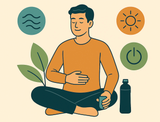First Aid Kit Essentials for Fall Outdoor Activities
As the vibrant colors of autumn take over the landscape, many of us are eager to get outside and enjoy the crisp air and stunning foliage. Whether you're hiking, camping, or simply spending time in the great outdoors, it's important to be prepared for any situation that might arise. One of the most crucial aspects of preparation is having a well-stocked first aid kit tailored to the unique challenges of fall outdoor activities. Here’s a guide to the essentials you should include in your first aid kit this season.
1. Bandages and Adhesive Dressings
- Why You Need It: Cuts, scrapes, and blisters are common when hiking on rocky trails or gathering wood for a campfire. Having a variety of bandages on hand ensures you can protect and treat these minor injuries before they become bigger problems.
- Recommended Options: Include a mix of adhesive bandages in different sizes, as well as larger gauze pads and adhesive tape. Moleskin is also a great addition for preventing and treating blisters.
2. Antiseptic Wipes and Ointments
- Why You Need It: Cleaning wounds promptly is critical to prevent infection, especially when you're far from medical facilities.
- Recommended Options: Pack antiseptic wipes, alcohol swabs, and antibiotic ointment to clean and protect cuts, scrapes, and other minor injuries.
3. Tweezers and Scissors
- Why You Need It: Tweezers are indispensable for removing splinters, ticks, and other small foreign objects, while scissors are useful for cutting tape, gauze, or clothing in an emergency.
- Recommended Options: Opt for high-quality stainless steel tweezers and a pair of small, sharp scissors designed for medical use.
4. Pain Relievers and Anti-Inflammatories
- Why You Need It: Long hikes and physical activities can lead to sore muscles, headaches, or minor injuries that benefit from pain relief.
- Recommended Options: Include a supply of over-the-counter pain relievers like ibuprofen or acetaminophen, which also help reduce inflammation.
5. Thermal Blanket
- Why You Need It: Fall weather can be unpredictable, with temperatures dropping quickly, especially at night. A thermal blanket can help retain body heat in an emergency, reducing the risk of hypothermia.
- Recommended Options: Pack a compact, lightweight emergency thermal blanket made of reflective material, which can be used for warmth or as a signaling device.
6. Insect Repellent and Bite Relief
- Why You Need It: Even as the weather cools, bugs like mosquitoes and ticks can still be a nuisance. Insect repellent is essential for keeping them at bay, while bite relief cream can help soothe any that get through.
- Recommended Options: Look for a repellent that protects against both mosquitoes and ticks. Include an antihistamine cream or stick to treat bites and stings.
7. Ace Bandages and Splints
- Why You Need It: Sprains, strains, and even fractures can happen unexpectedly during outdoor activities. Ace bandages provide support for sprains, while a lightweight splint can stabilize an injured limb until professional help is available.
- Recommended Options: Carry a couple of ace bandages in different sizes and a small, flexible splint that can be used for wrists, ankles, or fingers.
8. Hydration and Nutrition
- Why You Need It: Dehydration and low energy levels can quickly become serious issues when you're active outdoors. Hydration packs and energy bars can help keep you going strong.
- Recommended Options: Pack electrolyte tablets or powder to add to your water, and include energy bars or gels that provide a quick boost of calories.
9. Allergy Medications
- Why You Need It: Fall allergens like ragweed can cause allergic reactions, which can range from mild to severe. Having antihistamines on hand can quickly alleviate symptoms like sneezing, itching, or hives.
- Recommended Options: Include non-drowsy antihistamines for daytime use and a more powerful option for severe reactions. If you or someone in your group has severe allergies, an epinephrine auto-injector (EpiPen) is a must-have.
10. First Aid Manual
- Why You Need It: Even if you're experienced in outdoor activities, having a first aid manual on hand can provide valuable guidance in an emergency, ensuring you're prepared to handle unexpected situations.
- Recommended Options: Choose a compact, waterproof first aid manual that covers a wide range of injuries and medical emergencies.
Final Thoughts
Whether you're planning a short hike or an extended camping trip, being prepared with a well-stocked first aid kit can make all the difference in how you handle emergencies. By including these essentials in your kit, you'll be ready to tackle the unique challenges that come with fall outdoor activities. Remember, the goal is to enjoy the beauty of the season while staying safe and healthy.
At Truway Health, we offer a wide range of first aid supplies and kits designed to meet the needs of outdoor enthusiasts. Visit our website to explore our selection and ensure you're fully prepared for your next adventure.
Truway Health News & Insights
Truway Health Launches Innovative In-Vitro Cryo-Therapeutic Clinical Study
Advancing Cellular Preservation, Precision Therapy, and Translational Science Truway Health, Inc. is...
Everyday Stress, Handled: Practical Ways to Feel More Steady Day to Day
Everyday Stress, Handled: Practical Ways to Feel More Steady Day to Day Everyday stress is the mind-...
Creating Your Personalized Health Roadmap: Break Bad Habits and Build Long-Term Well-Being
Creating Your Personalized Health Roadmap: Break Bad Habits and Build Long-Term Well-Being Improving...
Breathe, Refuel, Recharge: Finding Your Daily Balance
Written by Perry JohanssenPublished and Edited by Truway Health Life rarely slows down on its own. B...
Truway Health Launches “ImmuneNet”: A New Era in Quantum-Synaptic Immunotherapy
Reimagining How Immunity Can Be Understood and Guided At Truway Health, innovation never sleeps.Toda...
Announcing the HEALTH Trial: Humanoid Evaluation and Learning in Healthcare
Published by Truway Health, Inc.Principal Investigator: Gavin SolomonClinicalTrials.gov Identifier:...







